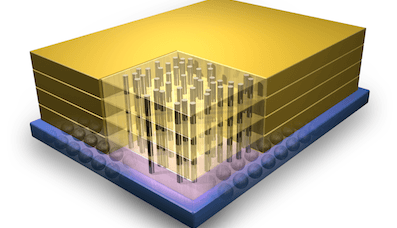Q&A: Engineering Professor On 3-D Stacked Systems
June 24, 2012
on
on

Ayse Kivilcim Coskun’s research on 3-D stacked systems has gained notoriety in academia, and it could change the way electrical engineers and chip manufacturers think about energy efficiency for years to come. In a recent interview with Circuit Cellar, the Boston University engineering professor briefed us on her work and explained how she came to focus on the topics of green computing and 3-D systems.
The following is an excerpt from an interview first published by C. J. Abate at Circuit Cellar. The entire interview appears in Circuit Cellar 264 (July 2012), which is currently on newsstands.
CC: When did you first become interested in computer engineering?
AYSE: I’ve been interested in electronics since high school and in science and physics since I was little. My undergraduate major was microelectronics engineering. I actually did not start studying computer engineering officially until graduate school at University of California, San Diego. However, during my undergraduate education, I started taking programming, operating systems, logic design, and computer architecture classes, which spiked my interest in the area.
CC: Tell us about your teaching position at the Electrical and Computer Engineering Department at Boston University (BU).
AYSE: I have been an assistant professor at BU for almost three years. I teach Introduction to Software Engineering to undergraduates and Introduction to Embedded systems to graduate students. I enjoy that both courses develop computational thinking as well as hands-on implementation skills. It’s great to see the students learning to build systems and have fun while learning.
CC: As an engineering professor, you have some insight into what excites future engineers. What “hot topics” currently interest your students?
AYSE: Programming and software design in general are certainly attracting a lot of interest. Our introductory software engineering class is attracting a growing number of students across the College of Engineering every year. DSP, image processing, and security are also hot topics among the students. Our engineering students are very keen on seeing a working system at the end of their class projects. Some project examples from my embedded systems class include embedded low-power gaming consoles, autonomous toy vehicles, and embedded systems focusing on healthcare or security applications …
CC: How did you come to focus on energy efficiency and thermal challenges?
AYSE: Energy efficiency has been a hot topic for embedded systems for several decades, mainly due to battery-life restrictions. With the growth of computing sources at all levels—from embedded to large-scale computers, and following the move to data centers and the cloud—now energy efficiency is a major bottleneck for any computing system. The focus on energy efficiency and temperature management among the academic community was increasing when I started my PhD. I got especially interested in thermally induced problems as I also had some background on fault tolerance and reliability topics. I thought it would be interesting to leverage job scheduling to improve thermal behavior and my advisor liked the idea too. Temperature-aware job scheduling in multiprocessor systems was the first energy-efficiency related project I worked on.
CC: In May 2011, you were awarded the A. Richard Newton Graduate Scholarship at the Design Automation Conference (DAC) for a joint project, “3-D Systems for Low-Power High-Performance Computing.” Tell us about the project and how you became involved.
AYSE: My vision is that 3-D stacked systems—where multiple dies are stacked together into a single chip—can provide significant benefits in energy efficiency. However, there are design, modeling, and management challenges that need to be addressed in order to simultaneously achieve energy efficiency and reliability. For example, stacking enables putting DRAM and processor cores together on a single 3-D chip. This means we can cut down the memory access latency, which is the main performance bottleneck for a lot of applications today. This gain in performance could be leveraged to run processors at a lower speed or use simpler cores, which would enable low-power, high-performance computing. Or we can use the reduction in memory latency to boost performance of single-chip multicore systems. Higher performance, however, means higher power and temperature. Thermal challenges are already pressing concerns for 3-D design, as cooling these systems is difficult. The project focuses on simultaneously analyzing performance, power, and temperature and using this analysis to design system management methods that maximize performance under power or thermal constraints.
I started researching 3-D systems during a summer internship at the Swiss Federal Institute of Technology (EPFL) in the last year of my PhD. Now, the area is maturing and there are even some 3-D prototype systems being designed. I think it is an exciting time for 3-D research as we’ll start seeing a larger pool of commercial 3-D stacked chips in a few years. The A. Richard Newton scholarship enabled us to do the preliminary research and collect results. Following the scholarship, I also received a National Science Foundation (NSF) CAREER award for designing innovative strategies for modeling and management of 3-D stacked systems.

Written by C. J. Abate of Circuit Celler. The entire interview appears in Circuit Cellar 264 (July 2012).
Circuit Cellar is part of the Elektor Group
Image credit 3D stacked system: IBM
The following is an excerpt from an interview first published by C. J. Abate at Circuit Cellar. The entire interview appears in Circuit Cellar 264 (July 2012), which is currently on newsstands.
CC: When did you first become interested in computer engineering?
AYSE: I’ve been interested in electronics since high school and in science and physics since I was little. My undergraduate major was microelectronics engineering. I actually did not start studying computer engineering officially until graduate school at University of California, San Diego. However, during my undergraduate education, I started taking programming, operating systems, logic design, and computer architecture classes, which spiked my interest in the area.
CC: Tell us about your teaching position at the Electrical and Computer Engineering Department at Boston University (BU).
AYSE: I have been an assistant professor at BU for almost three years. I teach Introduction to Software Engineering to undergraduates and Introduction to Embedded systems to graduate students. I enjoy that both courses develop computational thinking as well as hands-on implementation skills. It’s great to see the students learning to build systems and have fun while learning.
CC: As an engineering professor, you have some insight into what excites future engineers. What “hot topics” currently interest your students?
AYSE: Programming and software design in general are certainly attracting a lot of interest. Our introductory software engineering class is attracting a growing number of students across the College of Engineering every year. DSP, image processing, and security are also hot topics among the students. Our engineering students are very keen on seeing a working system at the end of their class projects. Some project examples from my embedded systems class include embedded low-power gaming consoles, autonomous toy vehicles, and embedded systems focusing on healthcare or security applications …
CC: How did you come to focus on energy efficiency and thermal challenges?
AYSE: Energy efficiency has been a hot topic for embedded systems for several decades, mainly due to battery-life restrictions. With the growth of computing sources at all levels—from embedded to large-scale computers, and following the move to data centers and the cloud—now energy efficiency is a major bottleneck for any computing system. The focus on energy efficiency and temperature management among the academic community was increasing when I started my PhD. I got especially interested in thermally induced problems as I also had some background on fault tolerance and reliability topics. I thought it would be interesting to leverage job scheduling to improve thermal behavior and my advisor liked the idea too. Temperature-aware job scheduling in multiprocessor systems was the first energy-efficiency related project I worked on.
CC: In May 2011, you were awarded the A. Richard Newton Graduate Scholarship at the Design Automation Conference (DAC) for a joint project, “3-D Systems for Low-Power High-Performance Computing.” Tell us about the project and how you became involved.
AYSE: My vision is that 3-D stacked systems—where multiple dies are stacked together into a single chip—can provide significant benefits in energy efficiency. However, there are design, modeling, and management challenges that need to be addressed in order to simultaneously achieve energy efficiency and reliability. For example, stacking enables putting DRAM and processor cores together on a single 3-D chip. This means we can cut down the memory access latency, which is the main performance bottleneck for a lot of applications today. This gain in performance could be leveraged to run processors at a lower speed or use simpler cores, which would enable low-power, high-performance computing. Or we can use the reduction in memory latency to boost performance of single-chip multicore systems. Higher performance, however, means higher power and temperature. Thermal challenges are already pressing concerns for 3-D design, as cooling these systems is difficult. The project focuses on simultaneously analyzing performance, power, and temperature and using this analysis to design system management methods that maximize performance under power or thermal constraints.
I started researching 3-D systems during a summer internship at the Swiss Federal Institute of Technology (EPFL) in the last year of my PhD. Now, the area is maturing and there are even some 3-D prototype systems being designed. I think it is an exciting time for 3-D research as we’ll start seeing a larger pool of commercial 3-D stacked chips in a few years. The A. Richard Newton scholarship enabled us to do the preliminary research and collect results. Following the scholarship, I also received a National Science Foundation (NSF) CAREER award for designing innovative strategies for modeling and management of 3-D stacked systems.

Written by C. J. Abate of Circuit Celler. The entire interview appears in Circuit Cellar 264 (July 2012).
Circuit Cellar is part of the Elektor Group
Image credit 3D stacked system: IBM
Read full article
Hide full article


Discussion (0 comments)